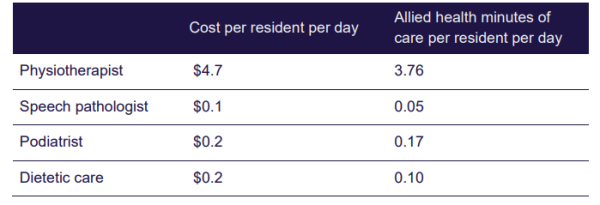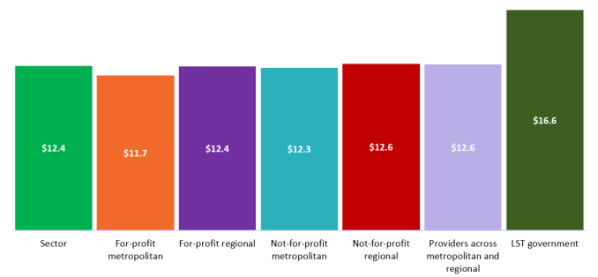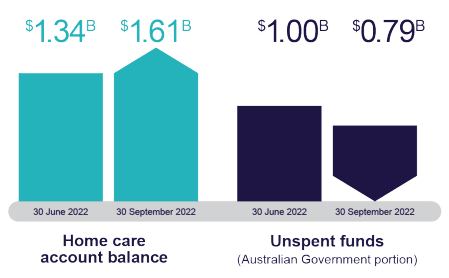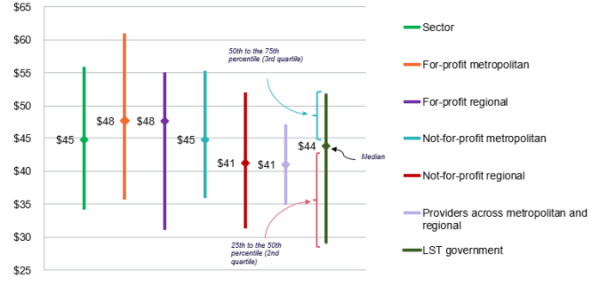Financial stress worse than thought, says provider peak
Responding to the government’s quarterly financial summary of the aged care sector, ACCPA CEO says the situation is worse than thought.

Responding to the government’s first quarterly financial summary of the aged care sector, chief executive officer of the Aged & Community Care Providers Association said the sector was in an even worse situation than stakeholders thought.
Published by the Department of Health and Aged Care – and released in response to a call for transparency by the royal commission – the Quarterly Financial Snapshot of the Aged Care Sector shows that 66 per cent of aged care homes operated at a loss for the period July to September 2022.

Speaking to Australian Ageing Agenda, ACCPA CEO Tom Symondson said the financial snapshot mirrorred reality. “The QFS reflects what the sector has been saying for some time – providers are struggling.”
The reasons for this vary, said Mr Symondson, and include the pandemic and workforce shortages. “Added to these elements is the fact that the aged care sector has not been adequately funded for many years, something we knew and something that was identified by the aged care royal commission.”
However, Mr Symondson told AAA that – with only 34 per cent of residential aged care providers reporting a profit – the situation is worse than stakeholders thought. “For the sector, that represents a loss of $465.3 million over the quarter or a potential full-year loss of $1.86 billion.”
Drawn from statistics collected from aged care providers through quarterly financial reports and data obtained through My Aged Care, the QFS is a point-in-time analysis of the financial performance of Australia’s aged care system.
For-profit and not-for-profit residential and home care providers are included in the inaugural report, which covers topics such as care minutes, staff costs, allied health, and food and nutrition.

The 27-page document shows that residential aged care providers made a net loss of $27.90 per resident per day – compared to home care providers making a net profit of $5.00 per care recipient per day.
Senior partner at StewartBrown Grant Corderoy told AAA the sector’s financial woes follow a predictable pattern. “The residential aged care loss of $27.90 per bed per day confirms that the sector is experiencing continuing financial pressures which have resulted in aggregate operating losses for the last five financial years.”
It should be noted, however, that the QFS results include non-recurrent expenses and exceptions, added Mr Corderoy – such as Covid, sanctions, refurbishments, rebuilds and closures, which would impact the overall result. “It is likely that the recurrent loss excluding the outliers would be closer to $22.00 per bed per day, which is still unsustainable.”

Average care minutes across the residential aged care sector totalled 187 minutes per resident per day including 34 from registered nurses, 15 from enrolled nurses and 138 minutes from personal care workers.
From October, providers will be expected to meet the mandatory requirement of an average of 200 minutes per resident per day, including 40 minutes of care from a registered nurse.
Reflecting on the mandatory minutes, Mr Symondson told AAA the change will only add to the sector’s financial pressures. “These challenges will only be compounded, with the requirements for higher minutes of care and RNs 24/7 coming in during 2023 the financial pressure this will place on providers.”

Mr Corderoy, on the other hand, believes providers may benefit from the mandated minutes – at least in the short-term. “With the AN-ACC subsidy now including additional funding for the mandated 200 minutes from October 2023, we expect that there will be a short-term benefit whilst the actual minutes are lower than the mandated amount. However, this benefit will progressively reduce as the cost of delivering these additional average 13 minutes is met.”
The median total care labour costs reported by the sector was $173 per resident per day.
Labour costs include:
- registered nurses
- enrolled nurses
- personal care workers
- care management staff
- allied health
- diversional/lifestyle/recreation/activities staff
- other non-care staff.
As for wages paid, the average hourly rate of direct care staff was $45 for registered nurses, $33 for enrolled nurses and $27 for personal care workers.
Aged care providers are required to make available, or to assist with access, to a range of allied health services for residents that need them. During the first quarter of 2022-23, the median cost and time for allied health services per resident per day was $7.10 and 5.6 minutes.
This included:

This is the first time providers have had to report on allied health care time and costs against specific categories.
Reporting on food and nutrition, the QFS shows providers spent $12.40 per resident per day, with an average of 81 per cent spent on fresh food and ingredients.

Charting a provider’s EBITDA margin – earnings before interest, taxes, depreciation, and amortisation – the QFS shows a median margin of 0.19 per cent (which means an EBITDA return of 19 cents for every $100 of revenue earned.)
Home care
Focusing on the home care sector, the QFS shows home care providers fared better than residential aged care operators during the period, with 78.4 per cent recording profits. Collectively, home care providers made a net profit before tax of $92.4 million.
Despite the result, Mr Symondson told AAA that ACCPA held worries for the sector’s financial prospects. “We are concerned about the longevity of the sector without funding intervention,” he said.

Meanwhile, the QFS shows unspent home care funding totalling $2.4 billion: $1.61 billion held by providers in the home care account balance and a further $800 million retained by Services Australia.
Mr Corderoy told AAA the amount of unspent funds exposes the flaws of the current home care funding model. “As nearly 96 per cent of these unspent funds are never utilised by the existing care recipients, it highlights the need to change the funding model so that allocated subsidy funding for each care recipient is actually used on care services delivery.”
The median total staff minutes afforded to home care clients during the period was 53.65 minutes per care recipient per day. This includes RNs, all personal care staff, allied health, other direct care staff, care management, and administration and support.
Unlike residential aged care, there is no mandated care minutes for home care providers.

The median total staff cost was $44 per client per day.
The average hourly rate for an RN working in the home care sector was $49, enrolled nurses earned $37 and personal care staff $32.
Crunching the EBITDA margin, the QFS shows providers recording a return of $8.86 for every $100 of revenue earned.

Upon release of the QFS, Minister for Aged Care Anika Wells said in a statement: “You can’t improve what you can’t measure which is why the Albanese Government is committed to stronger reporting and oversight in aged care. The snapshot shows the strain a decade of inadequate funding from the Coalition has put on the aged care sector.”
Addressing the aged care reforms, Ms Wells added: “The new AN-ACC model has been implemented, funding for 24/7 registered nurses is rolling out and we have committed to funding the aged care workforce value case – these changes will support the future of Australia’s aged care service providers’ finances and operations for the long term.”
Comment on the story below. Follow Australian Ageing Agenda on LinkedIn and Facebook, sign up to our twice-weekly newsletter and subscribe to AAA magazine for the complete aged care picture.




What difference would it make if a percentage of the interest made on RADS was used for CARE. Currently I understand that the interest can only be used to refurbish accommodation or build new assets. Many care recipients are under the impression that the RAD can be used for their care.
Unspent funds left in Home care packages are there because providers insist on exclusions which were previously inclusions. The relationship between providers and their clients is similar to a domestic violence power struggle with consumers begging for their inclusions while providers turn a deaf ear . Many consumers are despondent and tearful because providers give them a hard time .
So residential care providers expect to lose $1.86 billion over the year and the home care sector has almost $2.4billion of unspent funding…it’s not rocket science on how to fix this critical issue immediately!
What are the 34% of facilities who reported a profit doing differently and did any of them rate 5 stars?
Peter, I think what you have said is too simplistic for this very shonky industry. Firstly govetnment should start with genuine auditing and transparency to establish accurate honest figures woth fraud charges where thos is evidence to do so.
Then strip back all the wasted mega millions$ or evrn a billion from laughingly called ‘peak’ bodies and research and advisory bodies and any organisation claiming to represent the aged when there is little or no evidence of benefit to the aged.
Then stop changing the rules mid game and clean out the mrntality of providers described by Stella Perkins here. Allow rrcipients to use funds in accordance with legislation
Ban all false or disingenuous advertising by providers. Big $ ads on TV would clae back some mllions. Stop using the word ‘care’. Replace it with ‘service”